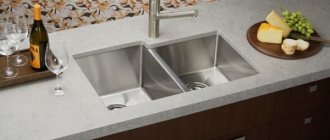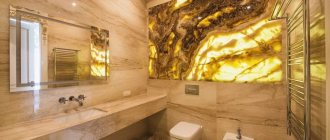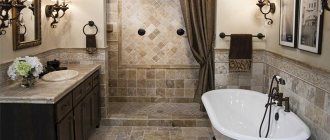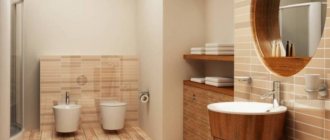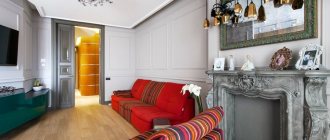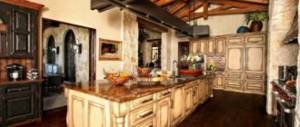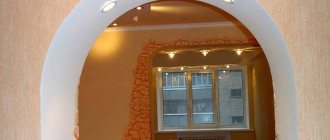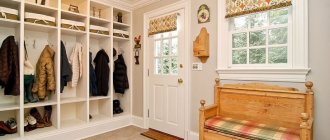Typically, decorative artificial stone acts as a reliable and effective cladding for the facades and plinths of country houses, as well as elements of the surrounding landscape: from retaining walls and fences to stairs and paths. However, stone elements of various textures and colors will just as successfully transform the walls of corridors, halls, living rooms, as well as individual structures and interior details.
Characteristics of natural stones
The facing stone is chosen from many varieties of natural materials. At the same time, the texture reflects the elegance, style and nobility of the structures being built.
To have an idea of the variety of natural materials, let's get acquainted with the most popular options.
Marble
The most common type of cladding. Marble has a rich palette of shades of white, red, gray, pink, green, brown and black. Stone patterns are created by its structure and depend on the methods of sawing the rock. The unique pattern of marble is used to create picturesque compositions.
Marble is characterized by many inclusions of different shades with veins and stripes. Processing methods affect the surface texture of the material: smooth, glossy or aged.
Cladding a fireplace with marble can be used in combination with other building materials. An excellent option based on marble stone, while maintaining high natural quality, is the use of ground marble.
Almost all varieties of rock are crushed into various fractions, which are used to produce marble mosaics or the main filler. Most often, monochromatic varieties of white and black marble are used.
Granite
It is one of the most durable, massive and durable types of materials. Finishing the fireplace with natural granite ensures the reliability and attractiveness of the structure. The natural texture fits harmoniously into the design of the space, containing matching granite objects, such as furniture or railings.
Granite material has unique decorative properties. The finish is characterized by bright patterns and uniform grain throughout the entire surface.
The location of extraction affects the variety of colors and its shades. High strength ensures long-term use. History has recorded facts of hundred-year-old granite fireplaces that still heat castles, as well as large mansions.
This stone is easy to process, providing the embodiment of a wide variety of design ideas. The combination of various slabs, mosaics, and collages created when facing the fireplace looks impressive. This design method gives exclusivity to each design element.
The use of granite to decorate a fireplace demonstrates the status of the owner and his attitude to life. Rich people enhanced the impression by using rare colors in order to add not just beauty, but to create originality and uniqueness of the interior.
Advantages of marble and granite for decoration:
- resistance to temperature changes;
- when heated, they do not emit harmful odors and smoke;
- always impressive appearance;
- combination with various building materials, such as wood, metal, glass, ceramics and other natural stones;
- undemanding operation;
- high strength, immunity to external influences.
Soapstone chlorite
Refers to a popular type of finishing materials. Thanks to its layered structure, it provides high heat capacity, so heat is retained in the stone and its surface is always warm.
They have known about it for many centuries. In Ancient Egypt and Asian countries, magical properties were attributed to it. The frequency of the emitted heat matches human radiation. The stone is believed to convey healthy natural strength when in contact with the human body. This strength increases the body's immunity and increases resistance to various bacteria and diseases.
In folk medicine there is information about the beneficial effects on human health, normalization of blood pressure, restoration of the respiratory system and metabolism.
Soapstone has high density, thermal conductivity and low thermal expansion. These qualities are best used when finishing fireplaces and stoves.
Sandstone
It is used for the front decoration of the fireplace, as it is resistant to high temperatures, durable and has a strong structure. Thanks to the uniqueness of this stone, a variety of original solutions for the fireplace are obtained.
It is easy to process and can be cut. It has a large selection of colors, shades and unique appearance. When facing with sandstone, you can create picturesque stone paintings.
This type of material best combines the qualities of decorativeness, environmental friendliness and affordable price.
Granite ceramics
Refers to a kind of finishing material, which is made from natural clay and is used for decorative finishing. The appearance is similar to the texture and color of granite, marble and similar stones.
This material differs from ordinary ceramic tiles only in the basis of its manufacture. Granite ceramics are made using especially durable clay. In other respects they are very similar, especially in appearance.
Thanks to the clay contained in porcelain stoneware, this material has a strong structure, is not subject to mechanical stress, is resistant to elevated temperatures and is durable. During operation, the finishing stone always retains its color and original shine.
Shell rock
It is one of the most unique natural stones that create an original fireplace lining. Thanks to its natural porous structure, it has high thermal insulation and resistance to high temperatures, which is an important factor for finishing a fireplace.
The shell rock contains the remains of fossilized sea shells and mollusks, which are preserved inside the stone.
To create the required shapes from shell rock, it is polished.
The most common yellow and white colors with various shades are successfully used for interior decoration. Cutting out original parts from sandstone-shell rock allows you to design the structure in accordance with any requests of the owners.
Cladding with natural stone is not always suitable for decorating fireplaces. Modern technologies make it possible to use materials that are superior to natural stones in terms of heat transfer.
Therefore, use stone to decorate fireplaces if you are satisfied with the low heat capacity of its surface.
It is important to know that:
- stone finishing reduces the efficiency of the structure, absorbing heat;
- facing the fireplace with granite can be done in the house if it is not the heat transfer that is important, but the presence of a live fire;
- the durability of marble and granite fireplaces is an indisputable fact.
If you use the softest of stones - limestone, then only after a few decades you will be able to see the destruction of its structure. Other stones are less susceptible to external influences, so finishing with natural materials does not have an expiration date.
Features of the material
At first, artificial stone was available only to public institutions, then, thanks to high competition, decorating with it became available to the private sector. For interior decoration, gypsum, acrylic, and quartz stones are produced.
Gypsum is an environmentally friendly, inexpensive material that creates additional noise and heat insulation. Gypsum stone is lightweight, easy to install, but very fragile. Home production is possible, if special molds are available. To do this, gypsum dough is mixed with the addition of colorant, poured into a mold and dried for three days. But such a process is long and not always advisable, especially since the price of the material is affordable.
Acrylic - differs from the previous one in that it is not afraid of moisture, does not absorb dust, dirt, is not afraid of impacts, and has a smooth surface that is afraid of abrasive cleaning agents. Also lightweight, environmentally friendly, non-flammable material. This type of finish is more expensive.
Quartz is the most durable, practical, but expensive. Its advantage is its resistance to temperature changes, that is, it can be used in a sauna or near a stove. A unique natural pattern is obtained through the use of marble, granite and quartz chips in the manufacture. Visually, the two materials differ slightly, but by touch you can distinguish plastic from stone.
Decorative stone for interior wall decoration is available in various designs. Imitation of brick, marble, sandstone, granite, bassoon is possible. The use of natural material may not only be unaffordable, but also impractical due to loss of space and installation features. Natural material is heavy, irregularly shaped, voluminous, difficult to lay out and glue. But its cost is much higher than imitation.
A special type is flexible stone. It is a thin strip of natural stone glued to a fabric base using polymers and sand chips. Decorative properties are superior to competitors, thanks to the variety of color combinations. The following advantages: lightness, flexibility, strength, non-flammability, heat resistance, ease of installation.
3
Interior finishing with natural minerals
Based on their origin, rocks are divided into:
volcanic (obsidian, basalt, granite); sedimentary (limestone, shales, sandstone, marble); associated ores (hematite, malachite, turquoise, dolomite).
The first are formed at the site of the release of magma from the bowels of the earth, the second arise deep in the solid crust of the planet under the pressure of overlying strata, and the third accompany various ore deposits, being their oxides and the results of other chemical processes. According to their purpose, minerals are classified as construction, decorative and ornamental . The latter can also be used for decoration, but the cost of such elements is quite high.
3.1
Basalt
It is formed from magmatic silicate melts that flow onto the surface of the earth's crust during volcanic eruptions from the deep layers of the mantle. It is distinguished by high strength and hardness, difficult to process, but extremely durable and reliable, resistant to mechanical damage building material. Crushed stone and fiber for insulation and sound insulation are made from it. It is the optimal raw material for stone casting. It is often used in finishing the facades of buildings and premises, for which it is given the form of slabs.
3.2
Granite
The mineral is ejected during volcanic activity from the upper layers of the mantle, and contains feldspar, mica and quartz. Even with constant mechanical impact, wear occurs extremely slowly and its first signs, as a result of surface abrasion, can appear after 100 years. Typically used in construction, but also very popular as a finishing material.
We recommend: How long does it take for polyurethane foam to dry?
It is widely used in external cladding, since it is completely impervious to weather conditions, moisture- and frost-resistant, and almost does not get dirty. In interior decoration, wall tiles are used less frequently, but with the right choice of design they allow you to achieve beautiful room decor.
3.3
Marble
It appears in the depths of the mountains as a result of a number of chemical processes in limestone, that is, it is a derivative of this sedimentary mineral. The main composition is calcite. It is widely used in decoration, especially floor and wall surfaces; columns, fireplace portals, countertops, stair steps and handrails are often made from it. This material is durable and hard to wear, although scratches easily occur on the polished surface under mechanical stress. Marble is antistatic and moisture resistant.
3.4
Dolomite
One of the varieties of carbonates, this rock accompanies lead and tin ores, transforming due to chemical processes from limestone. The color of the mineral depends on impurities and inclusions; for example, iron hydroxide gives a bright red color. The facing material is resistant to sudden temperature changes, moisture, and mechanical stress. After polishing it acquires a characteristic oily gloss.
3.5
Slate
Layered, as the name suggests, the rock is quite fragile, easily separated into separate plates. It can be used both as a cross-section so that the structure of the veins is visible, and as a finish with detached tiles.
Finishing with artificial materials
Interior decoration with artificial stones conveys the appearance of the power and strength of the stone, creating the original beauty of modern styles. The latest technologies make it easy to realize the most incredible fantasies using stone finishing.
Due to the ease of working with artificial stone, it is used for the manufacture of complex fireplace designs.
The advantages include:
- ease of processing and creation of various shapes and sizes when facing;
- light weight, which simplifies the decorating process;
- can be combined with other types of materials such as metal, glass or ceramics.
Using decorative stone to decorate a fireplace allows you to create surfaces similar in appearance to natural materials, while the work is much easier and faster.
The appearance of artificial stones among building materials allows the use of inexpensive analogues where expensive stones are purchased. At the same time, the functionality and aesthetics of the finishing quality are preserved.
Although, nevertheless, artificial stones may be inferior to natural ones in terms of energy and natural benefits. Natural stones can heal and fill a space with healing ions and vibrations. For these purposes, semi-precious or natural gems such as jadeite, agate, onyx or malachite are used.
The harmony of the home atmosphere created by a stone fireplace conveys not only beauty, but also a feeling of reliability, stability and well-being.
With the help of a fireplace lined with wild stone, you can create a work of art, and its originality and uniqueness will correspond to your plans and attitude to life.
Such a fireplace can only be in a single copy, because natural stones have a unique pattern and inimitable shades created by nature itself. A variety of color shades, different installation methods and decorations create the uniqueness and sophistication of your home.
>FINISHING WITH FLEXIBLE STONE – PROS AND CONS. INSTALLATION
The most popular types of stone for finishing a stove
Onyx
An expensive option, which at the same time allows you to get a unique visual result. Onyx looks really solid and confirms the high level of its owner. Well, the translucent structure of the mineral allows it to be used in combination with lighting, which makes it possible to create amazing designs. It is necessary to entrust the cladding of a fireplace with onyx exclusively to highly qualified specialists, since not every mason has the relevant experience.
Rubble stone
Natural stone, like the one under our feet. It has no special value, but attracts with its natural component and excellent appearance. Well, the low cost, in turn, is only a plus, as it makes such finishing accessible to many. It can be either natural or artificial. Moreover, the latter can be done with your own hands - by mixing cement, water, sand and pigments, and filling silicone molds created using natural stones with all this.
Important! Self-production of rubble stone based on gypsum is not carried out, since this material can crack under the influence of temperature changes.
Talkomagnesite
The mineral is of volcanic origin and is used for finishing stoves, both in bathhouses and in residential buildings, as well as fireplace structures. The attractive appearance gives solidity to any surface finished in this way. At the same time, the mineral perfectly accumulates heat, releasing it to the environment and warming up the room. The surface itself remains warm and pleasant to the touch.
Rhodonite
The ruby hue of this mineral allows you to obtain the most effective finish for a stove or fireplace. Translucency, glassy luster and interesting patterns make the mineral extremely recognizable. At the same time, rhodonite also has a high heat capacity, which allows it to be used both in the house and in the bathhouse.
Granite and marble
We put these two options together because they are the most popular. They are used almost everywhere, including in the finishing of stoves. Although the price is not the lowest, these stones have unique visual characteristics. But working with them on your own is very difficult, and it is better to entrust the process to professionals.
TECHNOLOGY FOR MANUFACTURING FLEXIBLE STONE
Flexible stone is a base made of non-woven fabric, coated with an adhesive substance with fiberglass, on which a thin layer of fine chips of natural stone is applied: marble, granite, quartz, sandstone, etc.
The material was invented by German designer Gernot Ehrlich in the mid-90s of the 20th century during the renovation of a stone countertop.
Currently, there are two ways to make flexible stone. The first is used in quarries. First, sandstone blocks that have a beautiful, interesting pattern are selected. Their surface is treated in a certain way, after which a base of non-woven fabric impregnated with glue is applied to it. After drying, the canvas is carefully cut off.
The second method is to carry out production in workshops and small workshops. In this case, it is no longer quarry stone that is used, but quartz sand of various shades, and the design has to be created independently. The work is not too difficult, but requires some skill.
Quartz sand or fine marble chips are applied to the fiberglass. At this stage, it is important to form an unusual texture, similar to the pattern of real sandstone. Next, high-quality acrylic glue is applied along with special additives. It acts as an impregnation that binds individual grains of sand. If the surface turns out to be lumpy, it is leveled. Then they are laid out to dry on wooden racks or pallets.
Advice
Pay attention to the pattern of one batch: for companies that work directly with the manufacturer, the pattern on all sheets will be almost identical. This is due to the fact that a very thin layer (from 1 to 6 mm) is removed from the stone; therefore, the pattern does not change radically.
The material is produced in the form of rolls (“stone wallpaper”) with a sheet size of 2840 x 1420 mm and a thickness of up to 3 mm, as well as in the form of slabs with a thickness of 2.5 to 6 mm.
Link on topic: “Ancient” stone for decorating walls with your own hands
Let's sum it up
Flexible stone is a lightweight finishing material with brilliant decorative capabilities. It was created to equally successfully replace natural stone for both interior and exterior decoration of buildings.
With such a replacement, there is no need for loading and unloading sandstone that is heavy for transportation, the need for cutting it, fastening problems and headaches from additional load on the foundation automatically disappear.
In addition, the flexible base of the stone allows this unique finishing material to decorate the most elaborate relief. And only the high cost crosses it off the list of the most popular finishing materials. But despite this, the circle of flexible stone connoisseurs is rapidly expanding.
If you find an error, please select a piece of text and press Ctrl+Enter.
However, after admiration comes irritation - offhand it seems that such a luxury is unlikely to be available to many.
However, this is not so, because neither granite nor marble was used to create these interiors. The secret of all this beauty is the use of a relatively new finishing material known as “flexible stone”. Even a budget acrylic bathtub in combination with it will look royally luxurious. So we decided to figure out what this innovative material is, and at the same time evaluate the complexity of the work involved in its installation.
The main component for the manufacture of flexible stone is either sandstone or fine marble sand. Particles of these natural materials are processed in a special way and applied to a textile base. Flexible stone comes on sale in the form of rolls or slabs, and for finishing work it can be used anywhere.
It is generally ideal for bathrooms because it is not afraid of dampness and moisture. In addition, this facing material is incredibly pliable and can be laid onto any shape using hot air. You feel it - the initially creepy sewer riser can now become an independent art object!
Due to its youth, flexible stone has not yet had time to stand the test of time, but manufacturers provide a 25-year guarantee, so durability can also be mentioned among the valuable properties of this material.
With environmental safety, everything is also in order - it does not contain formaldehydes that are harmful to health. It remains to add that you don’t need to look for special craftsmen to install it - if you have ever glued wallpaper, then you can easily apply flexible stone.
How to create such beauty
The technology of work is ridiculously simple, but first you need to stock up on the necessary tools. You will need: a mounting knife, a ruler with a pencil, a wooden hammer, a roller or brush and a notched trowel.
The requirements for the treated surface are approximately the same as in the case of wallpaper finishing. The area where the flexible stone is applied must be clean, dry and level, and the base can be anything - metal, glass, drywall or OSB. The flexible stone is mounted on a special glue that has increased thickness and viscosity. The adhesive must be applied directly to the wall using a notched trowel. If you use a flexible stone in a roll, then press it against the wall and roll it with a roller. The tiles are simply pressed tightly against the wall and beaten with a wooden hammer.
The seamless installation method is more labor-intensive, but it is worth it - as a result, the wall will look as if it was decorated with a piece of solid stone. To ensure that the joints are not visible, a hair dryer is used. The joints of the tiles are heated and sand is rubbed between them from the edges of the material.
When the glue dries, the surface of the flexible stone must be treated with a hydrophobic compound - it is sold in the same place as the stone itself. After such finishing treatment, the coating is not afraid of either water or dirt.
Flexible stone is an absolutely natural and environmentally friendly building material, which is not only easy to use, but also has a lot of positive characteristics. A strange name, but it becomes quite logical if you understand the structure of the mysterious finishing material. The technology for producing the finishing product will tell us how flexible stone is “mined.”
The production of flexible stone is based on sandstone - it is also the presentable front side of the product. Sandstone creates unique interior compositions. The shade and pattern of the sandstone used gives the unique color of the future material. Sandstone makes up only 1mm of the entire thickness, the rest is fabric, high temperature polymer and fiberglass. The sandstone is cut thinly and then sanded to obtain a perfectly smooth surface, after which it is attached to a textile backing. Then, the finished material is dried.
Flexible stone production technology
The material is made entirely by hand, so it has a fairly high price. It is produced in this way: a fabric sheet is glued to the surface of natural sandstone, as a result of which a thin layer of stone remains on the fabric. The fabric is torn off and dried. This product completely replicates the pattern and color of sandstone. Its thinnest stone layer provides the material with strength, fire safety, and resistance to mechanical stress.
The resulting sample bends, which is why it got the name - flexible stone. The production of flexible stone allows you to obtain samples of various thicknesses; it is made into either rolls (due to the flexibility of the base) or tiles and sent to shops and market stalls. Features of technological processes determine the acquired advantages and disadvantages of flexible stone.
ADVANTAGES AND DISADVANTAGES OF FLEXIBLE STONE
Thanks to the flexibility of the stone coating, any shape can be faced: round, stepped, curved. Another advantage is the wide selection of colors and textures: it is possible to choose a pattern to suit any interior style. In addition, flexible stone is not subject to fire and does not absorb moisture.
The material is made from safe and environmentally friendly components, has good breathability and does not emit any harmful substances. This allows it to be used in rooms where children are constantly present.
Ease of installation is also a big plus, since gluing a stone sheet is no more difficult than gluing wallpaper. And to process it you don’t need a professional tool: flexible stone can be cut with ordinary scissors. The low weight of the sheets (from 3 to 5 kg/m2) is a decisive factor in the case when the weight of the cladding should not exceed a certain value.
It is worth mentioning the shortcomings, of which there are very few.
The most significant one is the price. Flexible stone is not a cheap pleasure: the cost per square meter starts from 900 rubles. However, they most likely will not sell you one or two “squares”: you will have to buy a roll or package.
The downside is that there are a large number of fakes sold on the market. In their manufacture, cheaper components are used (in particular, glue).
Because of this, stone chips begin to crack and crumble over time.
Types of tiled artificial stones
Working with artificial stone is no more difficult than working with ordinary ceramic tiles, and learning the technology of laying wall coverings is accessible to anyone who wants to master the craft of a tile maker. The only difference is in the adhesives used to install the cladding. The result of using decorative stone tiles will be the improvement of the hygienic conditions of the room, the beauty and durability of the coating.
Decorative plates made to look like natural stone are gaining more and more popularity for interior decoration of apartments, and when there is demand, many offers appear. This is expressed in various types of decorative stone wall tiles:
Concrete - cement-based, is the most popular due to its affordable price. The compositions include natural fillers: expanded clay and ceramic chips - clay firing products, pumice, sand. Dyes give the stone the desired shade, and the design of the mold determines the texture of the finished item. It is used not only for interior decoration, but also for the design of external facades. Gypsum - a type of fragments made using alabaster - one of the varieties of natural mineral. This is the lightest imitation of natural rock, it is durable and can be attached to the wall even with ordinary PVA glue. It has good breathability and this helps maintain optimal humidity in the room. The disadvantages are high hygroscopicity - getting wet can lead to destruction of the tiles, and the fragility of the material.
Acrylic - artificial stone is not afraid of moisture and is considered one of the most shock-resistant. Caring for such cladding is completely simple: wipe the fragments of the coating with a cloth soaked in water without adding any chemicals. Porcelain stoneware type of elements - produced by high-temperature (over 1000 ºС) firing after pressing a dry mixture of clay and chips of natural rocks - granite, marble. This artificial stone easily withstands temperature changes and is suitable for exterior cladding of buildings. It is often used as a floor covering. Agglomerate type - similar in composition to the previous type of tiles, but the components of the dry mixture are bonded into a monolith not by firing, but by polymer resins or cement. The range of rocks included in the composition has been expanded to include quartzite, and pigments are added for bright colors. Such decorative stone-like tiles are used for interior decoration.
We recommend: How to make an artificial stone with your own hands at home: step by step we make an artificial decorative stone
From the latest technological developments, a liquid type of artificial tiles is known - it is produced from polymer materials. Plates made according to the new scheme are resistant to external influences, are available in many shades, are easy to clean and are versatile in creating an interior of any style. Liquid stone, which has an external resemblance to granite, is used to make facing tiles for interior decoration, bar counters, sinks and countertops.
HOW TO GLUE FLEXIBLE STONE WITHOUT SEAMS - VIDEO
Flexible stone, how to glue without seams 720p
ATTENTION!
When purchasing, do not forget to make sure that the thickness of the sheets is the same on all sides. Otherwise, differences in thickness will be noticeable at the joints.
Since the glue does not set instantly, you will have time to use a rubber roller to remove air bubbles from under the surface. The sheets are glued end-to-end, carefully smoothing the edges, or, less commonly, overlapping. In the second case, excess material is removed with a cutter.
To finish corners, columns, and complex curved elements, it is recommended to heat the edges of stone sheets with a hair dryer.
After gluing is completed, the surface is treated with a finishing impregnation, which further protects and strengthens the cladding.
ADVICE
If breaks or too obvious joints appear during installation, they can be eliminated at the finishing stage. The surface of the stone is covered with an impregnating composition and it is also applied to the pieces of material remaining after the work. These scraps are used to fill seams or gaps until they merge with the surface and become invisible. After the composition has dried, you can brush off the remaining grains of sand.
The technology for installation on building facades is similar. You just need to take into account that the air temperature should not be lower than 12°C, and it is better to apply the finishing coat not in one, but in two layers.
Guarantee of success: the right choice of materials
The durability of any building is determined by the quality of the materials used as a basis. To make your home happy for many years, you should not skimp on purchasing good raw materials.
What stone is suitable for stove construction?
When choosing a stone for a stove in a bathhouse, it is important to consider that heat-resistant rocks that can withstand high temperatures without cracking are suitable for masonry. Rubble stone made from rocks such as granite and sandstone copes well with the tasks.
Rubble stone can be irregular in shape, in the form of a slab or cobblestone. Naturally, preference should be given to the form that will allow you to use as little solution as possible. The selection of elements that suit each other will have to be carried out throughout the entire masonry process, carefully selecting the closest “neighbors” before each row. The thinner the seams, the stronger and more durable the structure will be.
In recent years, the title of the most “stove” stone has been occupied by soapstone - a unique material that heats up 10 times faster than brick and is capable of retaining accumulated heat for a day. Soapstone (as it is popularly called) has long been credited with medicinal properties. When processed, soapstone resembles marble, so it can be used for lining stoves made of inexpensive materials, thereby significantly improving their appearance and heat transfer.
Soapstone heats up 10 times faster than brick
For those who do not know the secrets of masonry, but dream of building a stone stove for a summer house or home with their own hands, ready-made kits for building stoves and fireplaces from soapstone are suitable. Such sets are reminiscent of a children's construction set, in which you need to assemble all the elements according to the attached diagram. If necessary, you can choose a stove equipped with a hob and oven. The weight of the finished product is from 500 to 2000 kg.
The right choice of clay is the key to structural strength
When laying a stove made of natural stone, it is recommended to choose refractory or refractory clay of good quality and normal fat content. Oily clay will crack quickly, and the lack of this indicator will affect the quality of the bond.
To ensure the suitability of the clay, prepare a stiff dough from a small amount, knead it thoroughly with your hands and roll it into a ball with a diameter of about 5 cm. The resulting ball is placed between two planks and lightly pressed on top. It’s good if cracks do not immediately appear on the ball, and their size is insignificant.
Having decided on the quality of the clay, they decide how much sand needs to be added to the solution. Also, to increase strength, you can add table salt and cement to the masonry mortar, and a little lime to the plaster mixture.
What to make a firebox from
The temperature in the firebox can rise to 1000 degrees and above, so materials that are not afraid of high temperatures should be used here. In stone stoves for a summer residence, you can install a ready-made cast iron firebox or lay out this most important component from fireclay bricks.
Finished cast iron firebox
The good thing about a brick firebox is that it gradually releases heat and continues to retain it after the combustion process ends. However, even refractory bricks deteriorate over time and require periodic replacement. Repairing the firebox is a rather labor-intensive and dirty process, so if you frequently use the stove for its intended purpose, it makes sense to take a closer look at more practical metal blanks.
Ready-made fireboxes are cast iron chambers installed in the furnace structure. Their advantages include ease of installation, durability, and high efficiency. As a rule, factory fireboxes are already equipped with a reliable door made of metal or special glass. To smoothly reduce the temperature, cast iron fireboxes are recommended to be insulated on the outside with fireclay bricks.
How to line a finished stove
Traditionally, stoves were lined with tiles - decorative clay products in the shape of a box. Thanks to the voids filled with clay and crushed stone during laying, the thermal efficiency of the fireplace is significantly increased.
Tiles - beauty and thermal efficiency
Terracotta tiles are another time-tested solution for decorating a stone stove. Terracotta is not afraid of temperature changes, so it is not afraid of splashes of cold water on a hot surface.
Among modern proposals, it makes sense to take a closer look at clinker tiles and porcelain stoneware. These tile materials are difficult to distinguish by appearance from expensive natural stones. They can withstand both high temperatures and high humidity, so they can be safely used not only in residential buildings, but also in bathhouses.
Cladding with natural stone will be appropriate if a stone stove for your home needs a chic design. Marble is ideal for this purpose - it is a beautiful and durable material. As a budget option, you can consider finishing with artificial stone that imitates expensive minerals.
Stone finishing of stoves and fireplaces
2014-07-23 Author:Vera Category:Design and decoration of fireplaces Views: 11648
Fireplaces in the living space give it a comfortable and cozy atmosphere. The family always gathers around this building over a cup of tea. The design of the fireplace plays a big role. Stone finishing of fireplaces has become popular at the moment.
Fireplace finishing options
What kind of fireplaces can be
Today, the choice of a fireplace for a living space depends on the functionality of the building itself. Very often people want to buy a solid fuel boiler.
There are two types of structures:
- Real fireplaces and stoves that run on fuel.
- False fireplaces, which are powered by electrical energy and are screens.
For both types, it is necessary to build a box.
Real fireplaces are divided into:
- Standard (open firebox).
- With cast iron and steel firebox.
- Gas fireplace.
- Stove-fireplace.
- Electrical unit.
Characteristics:
- The most popular and practical are standard fireplaces that have an open firebox. They run on wood or coal and are made from fireproof materials such as brick and aerated concrete. If interior finishing work is not carried out in principle, then exterior work is mandatory.
- Fireplaces with cast iron or steel fireboxes are similar to standard structures, they just can maintain the same temperature for a very long time and are not subject to combustion and oxidation. These fireplaces, like the previous ones, are durable.
- Gas fireplaces are designed primarily for home heating. They are not a very attractive design. But, if you draw up a fireplace design correctly, you can also perform finishing work.
- Fireplace stoves have become very popular recently. They are not only decorative elements of the interior, but also heating ones. They look more attractive than regular gas ones, see photos.
Decorative multifunctional fireplace for an apartment
Note. An electric fireplace can be found not only in the house, but also in the apartment. It is an electrical screen, which is placed in a special box.
This design is usually made from:
- Drywall.
- OSB sheets.
- Brick (in rare cases).
Finishing fireplaces with stone involves the use of natural agglomerates and artificial stones (see Decorative cladding of fireplaces).
Natural stones in the decoration of fireplace designs
Natural agglomerates are used quite often in the decoration of fireplaces and stoves (see “Calling fireplaces with marble, interior ideas”). Just before choosing a stone, you need to consider its size and weight.
In most cases, boxes are laid out of them, and the fireboxes themselves can be made of:
- Fire bricks.
- Cast iron.
- Steel and other materials.
Benefits of natural stone
Decorating a fireplace using natural stone
Natural stone has excellent properties. It is moisture resistant and, most importantly, does not burn and is not exposed to high temperatures, and does not deform from a direct fire source.
Other technical specifications:
- It is durable and can withstand quite significant loads. Therefore, it is often found that stoves are finished with stone of natural origin, which have a separate firebox (cast iron or steel).
- It is almost impossible to split natural stone and therefore a tile cutter is used to cut it. It is not so easy to lay a fireplace out of it, since in most cases it does not have a rectilinear shape.
- Also, the stone has a large mass and it is because of this (if the stone has a tiled shape) that it is necessary to strengthen the surface.
- For this purpose, a reinforced construction mesh made of wire is used, which is mounted on the surface using plaster or concrete mortar.
Advice. To ensure that the finishing of the fireplace with stone of this origin is strong and durable, it is best to use cement mortar (cement grade 400).
Artificial stone for finishing stoves and fireplaces
This is how you can decorate a fireplace using artificial stone
Artificial stone has been used for decorating fireplaces for quite some time. It has almost the same properties as natural agglomerate. It has a fairly wide variety of sizes and imitations (see: Cladding a fireplace with decorative stone).
Advantages of decorative stones:
- The main advantage of such a finishing material is its price, which is several times less than the cost of natural agglomerate. Also, the stone is quite diverse in its design, which allows you to create an interesting fireplace design.
- The stone, with its surface protected by special means and films, is moisture resistant and has a very long service life. It is durable and reliable and can withstand a variety of loads.
- It does not burn or melt. But this largely depends on the type of artificial stone. It does not deform when exposed to high temperatures that can result from fireplaces.
Decorative stone is quite easy to install, and you can easily carry out the entire process with your own hands. The quality of such work is significantly influenced by the preparedness of the surface for finishing it with decorative stone.
Artificial stones that are found in the interior
Decorating a fireplace with artificial stone is very popular. For this, the following types of finishing materials are used:
- Gypsum stone.
- Acrylic.
- Based on natural agglomerate crumbs.
- Flexible stone (innovation).
Gypsum stone is very common. It can have a glossy or matte surface.
Advice. If the surface of the gypsum stone is not covered with a protective layer, then it is necessary to treat it with varnish or other means that will protect the layer.
Peculiarities:
- Decorative stone made of gypsum is very practical and it is quite common to decorate a fireplace of this type with artificial stone. It can be in the form of sandstone, marble and other materials.
- Acrylic stone is stronger and more durable. It has a variety of imitations, surfaces and shapes. Its outer part is well protected and because of this it is used in the decoration of rooms and decorative elements, where there are constant temperature changes and high air humidity.
- Acrylic stone is stronger and more durable. It has a variety of imitations, surfaces and shapes. Its outer part is well protected and because of this it is used in the decoration of rooms and decorative elements, where there are constant temperature changes and high air humidity.
- Decorative stone based on marble, granite and other chips is also popular. It looks quite attractive and cannot be immediately distinguished from natural agglomerate by its appearance. Such material is used not only for the design of fireplaces, but also the stove is often finished with decorative stone of this type.
Note. The newest and most popular material at the moment is flexible stone.
Flexible stone for decoration
Decorating a fireplace using flexible stone
Decorating fireplaces with flexible stone is quite popular due to its lightness and practicality. There will be no need to use concrete or cement mortars for installation.
The technology for making such a stone is also simple. It is made from thin layers of natural stone, which is processed with synthetic agents that give the stone flexibility and elasticity (see Decorative cladding of stoves).
Advantages of flexible stone
Finishing a fireplace with flexible stone is durable, since the service life of such material is at least 15-20 years. It does not burn or melt, and does not emit any substances harmful to human health.
Don’t forget about the wear resistance of the material. Its surface is moisture-resistant and practical, and is quite easy to clean. To do this, use rags and water.
Advice. To clean the surface of flexible stone, you do not need to use cleaning agents or detergents that can damage the surface.
Due to the fact that the stone has excellent plasticity, it is very easy to install on a surface and the principle of such work is similar to wallpapering.
The process of finishing stoves and fireplaces with decorative stone
Stages of decorative stone finishing work
Decorating a fireplace with decorative stone begins with preparatory work on the surface.
Surface preparation:
- The stone can only be mounted on a flat surface. For this, plasterboard can be used, which is used in almost all repair work and is a universal material, and plaster, which has its own specific technology of use.
- We can say that there are special instructions for this, following which it is possible to complete the preparation very quickly.
Advice. Since the process of installing drywall that is attached to the frame is very simple and differs from using plaster in the purity of the process, it is best to use drywall to prepare the surface.
Installation of decorative stone
Do-it-yourself decorative stone installation
Finishing a fireplace with stone is done using:
- Concrete solution.
- Cement mortar.
- Adhesive solution.
Stages:
- For more massive stones, concrete or cement mortar is used. For flexible material, special glue is used.
- The product is applied both to the surface of the fireplace itself and to the inside of the material using a spatula.
Advice. To install decorative flexible stone, it is better to use brushes, since the stone is thin plates that resemble wallpaper.
- After installing solid decorative stones, you can use putty for the joints of the material.
Advice. To increase the strength of finishing using flexible stone, all joints are glued with a special construction tape to ensure uniform adhesion of the finishing material.
- Very often, the surface of flexible stone is varnished to protect the layer and extend its service life. The same actions can be carried out on the surface of other types of stones for the same purposes.
- Do not forget that some types of decorative stones should not be used in rooms with high air humidity, for example, gypsum.
Since decorative stone is very light, there is no need to reinforce the surface for its installation using reinforcing mesh, as when installing natural stone. Watch the video on how you can decorate a fireplace with your own hands.
Construction of a foundation for a stone stove
It is known that stone stoves are much heavier than their brick followers, which means they require a powerful and solid foundation. Without an additional foundation, it is allowed to install furnace equipment weighing no more than 750 kg. In this case, it will be enough to strengthen the floor and lay a layer of thermal insulation.
Ideally, the foundation for the stove is laid before the house is built.
The depth of the foundation for a stone stove should be at least half a meter; when calculating this parameter, it is important to take into account not only the mass of the stove with the pipe, but also the composition of the soil. Each side of the pit should be 5 cm larger than the corresponding wall of the future stove.
The bottom of the pit is covered with crushed stone, compacted well and filled with cement mortar. The foundation walls are laid out with red brick or rubble stone, observing the dressing; you can also build formwork and fill the walls with concrete mortar. The internal space of the pit is filled with small rubble and filled with liquid solution. A continuous layer of refractory brick must be laid on top.
Choosing a location for a home stove
If a stone stove for a home serves not only for decoration, but also fulfills its main task - heating a living space, it is necessary to choose the right place for it, taking into account not only safety precautions, but also maximum operating efficiency.
The ideal room for a fireplace is the room where the owners spend the most time, usually a living room with an area of at least 16 square meters. m. To get maximum thermal energy from the heat source, it is recommended to place the stove in the center of the room. Installing a heating device near external walls is extremely undesirable - in this case, part of the heat will be used to heat the street.
The stove is the heart of every home
If it is necessary to heat several adjacent rooms, the stove is erected in the opening of a common internal partition. In this case, it is advisable to place the structure so that the firebox door is in the hallway or in the kitchen. One stove can heat no more than four adjacent rooms.
Of course, the construction of stone stoves for the home, cottage and bathhouse is a difficult job, which can only be undertaken with certain skills in the stove business. All other lovers of the classics are strongly recommended to turn to professional craftsmen who know the secrets and subtleties of this difficult process.
>Video: unique sauna stove
